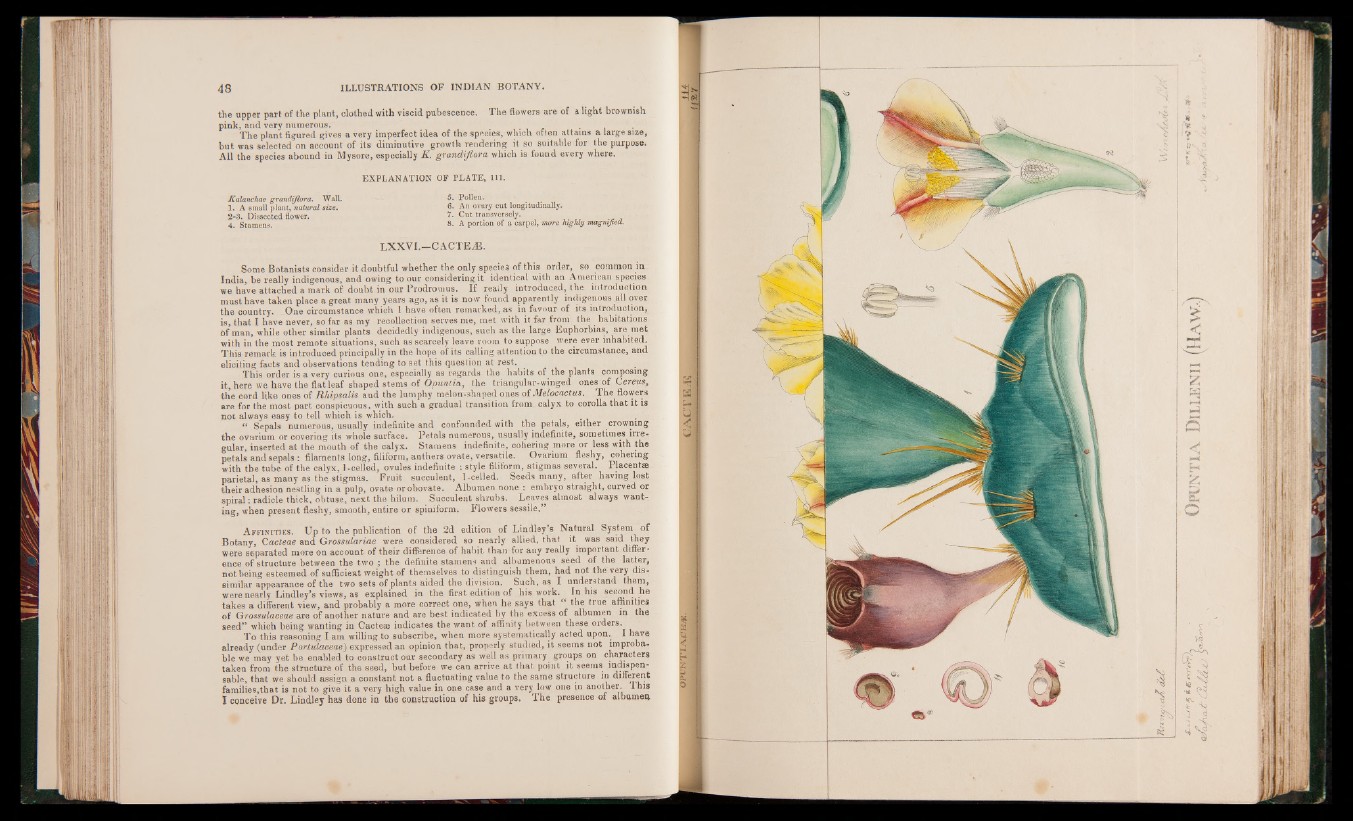
the upper part of the plant, clothed with viscid pubescence. The flowers are of a light brownish
pink, and very numerous. . .
The plant figured gives a very imperfect idea of the species, which often attains a large size,
but was selected on account of its diminutive growth rendering it so suitable for the purpose.
Ail the species abound in Mysore, especially K. grandiflora which is found every where.
EXPLANATION OF PLATE, 111.
Kalanchae grandiflora. Wall
1. A small plant, natural size.
2-3. Dissected flower.
4. Stamens.
5. Pollen.
6. An ovary cut longitudinally.
7. Cut transversely.
8. A portion of a carpel, more highly magnified.
LXXVI.-CACTE.d3.
Some Botanists consider it doubtful whether the only species of this order, so common in
India, be really indigenous, and owing to our considering it identical with an American species
we have attached a mark of doubt in our Prodromus. If really introduced, the introduction
must have taken place a great many years ago, as it is now found apparently indigenous all over
the country. One circumstance which 1 have often remarked, as in favour of its introduction,
is, that I have never, so far as my recollection serves me, met with it far from the ^ habitations
öf man, while other similar plants decidedly indigenous, such as the large Euphorbias, are met
with in the most remote situations, such as scarcely leave room to suppose were ever inhabited.
This remark is introduced principally in the hope of its calling attention to the circumstance, and
eliciting facts and observations tending to set this question at rest.
This order is a very curious one, especially as regards the habits of the plants composing
it, here we have the flat leaf shaped stems of Opuntitx, the triangular-winged ones of Cereus,
the cord like ones of Rhipsalis and the lumphy melon^shaped ones of Melocactus. The flowers
are for the most part conspicuous, with such a gradual transition from calyx to corolla that it is
not always easy to tell which is which. .
** Sepals numerous, usually indefinite and confounded with the petals, either crowning
the ovarium or covering its whole surface. Petals numerous, usually indefinite, sometimes irregular,
inserted at the mouth of the calyx. Stamens indefinite, cohering more or less with the
petals and sepals : filaments long, filiform, anthers ovate, versatile. Ovarium fleshy, cohering
with the tube of the calyx, Lcelled, ovules indefinite : style filiform, stigmas several. Placent®
parietal, as many as the stigmas. Fruit succulent, 1-celled. Seeds many, after having lost
their adhesion nestling in a pulp, ovate or obovate. Albumen none : embryo straight, curved or
spiral: radicle thick, obtuse, next the hilum. Succulent shrubs. Leaves almost always wanting,
when present fleshy, smooth, entire or spiniform. Flowers sessile.”
A ffinities. Up to the publication of the 2d edition of Lindley s Natural System of
Botany, Cacteae and Grossulariae were considered so nearly allied, that it was said they
were separated more on account of their difference of habit than for any really important difference
of structure between the two ; the definite stamens and albumenous seed of the latter,
not being esteemed of sufficient weight of themselves to distinguish them, had not thé very dissimilar
appearance of the two sets of plants aided the division. Such, as I understand them,
were nearly Lindley’s views, as explained in the first edition of his work. In his second he
takes a different view, and probably a more correct one, when he says that ec the true affinities
of Grossulaceae are of another nature and are best indicated by the excess of albumen in the
seed” which being wanting in Cacteae indicates the want of affinity between these orders.
To this reasoning I am willing to subscribe, when more systematically acted upon. I have
already (under Portulaoeae) expressed an opinion that, properly studied, it seems not improbable
we may yet be enabled to construct our secondary as well as primary groups on characters
taken from the structure of the seed, but before we can arrive at that point it seems indispensable,
that we should assign a constant not a fluctuating value to the same structure in different
families,that is not to give it a very high value in one case and a very low one in another. I his
Ï conceive Dr. Lindley has done ia the construction of his groups. The presence of albumeii
o p u n t i a c b a i . C A v C T E Æ